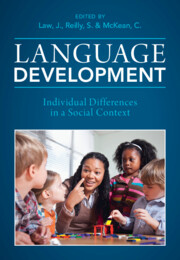Book contents
- Language Development
- Language Development
- Copyright page
- Contents
- Figures
- Tables
- Contributors
- A Tribute to Our Friend, Colleague and Fellow Editor, Professor James Law
- Introduction
- Part One Factors Influencing Language Development
- Part Two Continuity and Change
- Part Three Impact, Intervention and Equity
- 15 Communication, Participation and Cohort Studies
- 16 Capturing the Voice of Parents and Children
- 17 Oral Language Skills as a Foundation for Learning to Learn
- 18 The Economic Impact of Low Language Ability in Childhood
- 19 A Review of Interventions to Promote Language Development in Early Childhood
- 20 Interventions to Promote Language Development in Typical and Atypical Populations
- 21 The Effect of Kindergarten Instructional Policies on Reading and Math Achievement Gaps
- 22 Educational Interventions Targeting Language Development
- 23 Equity and Access to Services for Children with Language Difficulties
- Index
- References
15 - Communication, Participation and Cohort Studies
from Part Three - Impact, Intervention and Equity
Published online by Cambridge University Press: 11 August 2022
- Language Development
- Language Development
- Copyright page
- Contents
- Figures
- Tables
- Contributors
- A Tribute to Our Friend, Colleague and Fellow Editor, Professor James Law
- Introduction
- Part One Factors Influencing Language Development
- Part Two Continuity and Change
- Part Three Impact, Intervention and Equity
- 15 Communication, Participation and Cohort Studies
- 16 Capturing the Voice of Parents and Children
- 17 Oral Language Skills as a Foundation for Learning to Learn
- 18 The Economic Impact of Low Language Ability in Childhood
- 19 A Review of Interventions to Promote Language Development in Early Childhood
- 20 Interventions to Promote Language Development in Typical and Atypical Populations
- 21 The Effect of Kindergarten Instructional Policies on Reading and Math Achievement Gaps
- 22 Educational Interventions Targeting Language Development
- 23 Equity and Access to Services for Children with Language Difficulties
- Index
- References
Summary
Communication is both an activity in which we participate and the means by which we participate in a range of other activities. Therefore, the ability to communicate (or ‘communication capacity’) is closely linked with the ability to participate in life activities and in society. Cohort studies that consider communication capacity and explore participation in life activities provide an opportunity to understand these links at a single point in time or longitudinally. This chapter introduces the reader to four Australian cohort studies: Longitudinal Study of Australian Children (LSAC), Longitudinal Study of Indigenous Children (LSIC), Building a New Life in Australia: The Longitudinal Study of Humanitarian Migrants (BNLA), and the Australian Census of Population and Housing. The WHO's International Classification of Functioning, Disability and Health (ICF) is used as a framework to examine links between communication and participation. The chapter presents communication and participation data from the four cohort studies for children and adults who have speech, language and communication needs (SLCN), as well as people who are Indigenous (First Nations), multilingual and migrants, to reflect strengths and capacity within communities and societies.
Keywords
- Type
- Chapter
- Information
- Language DevelopmentIndividual Differences in a Social Context, pp. 351 - 375Publisher: Cambridge University PressPrint publication year: 2022

